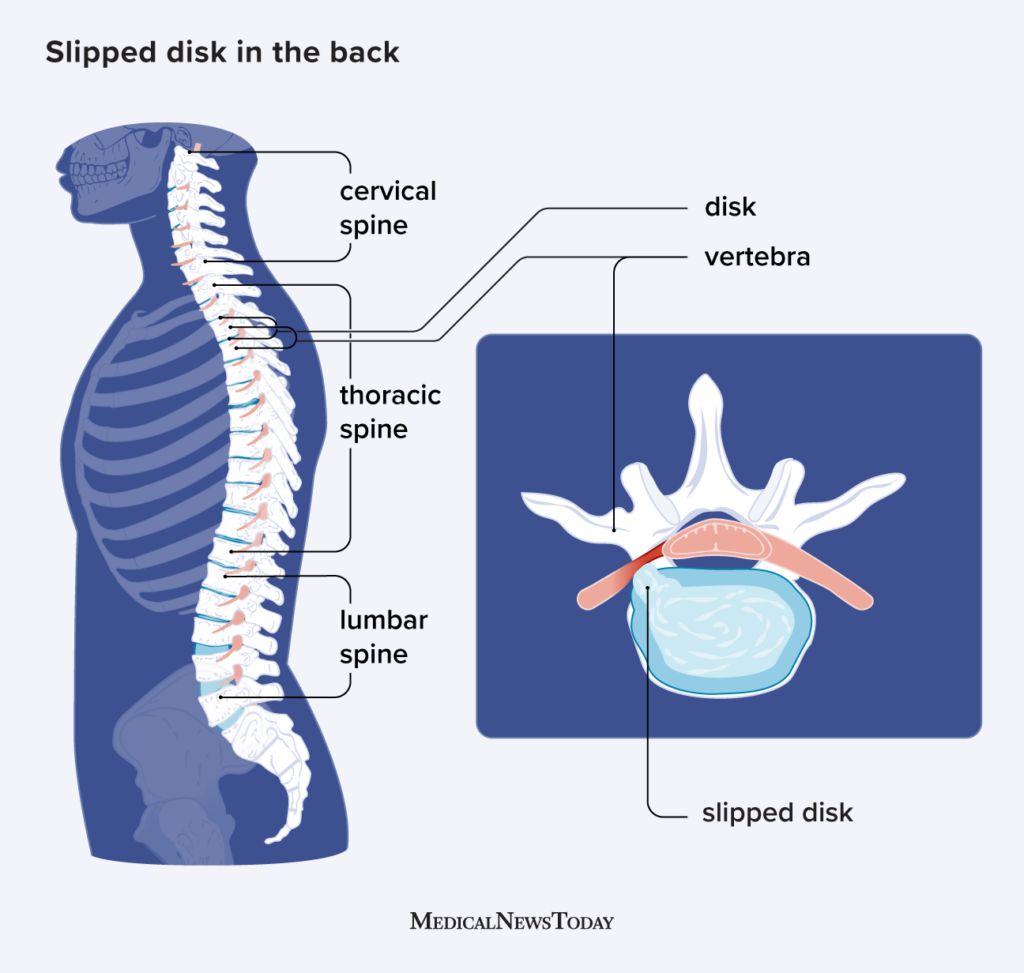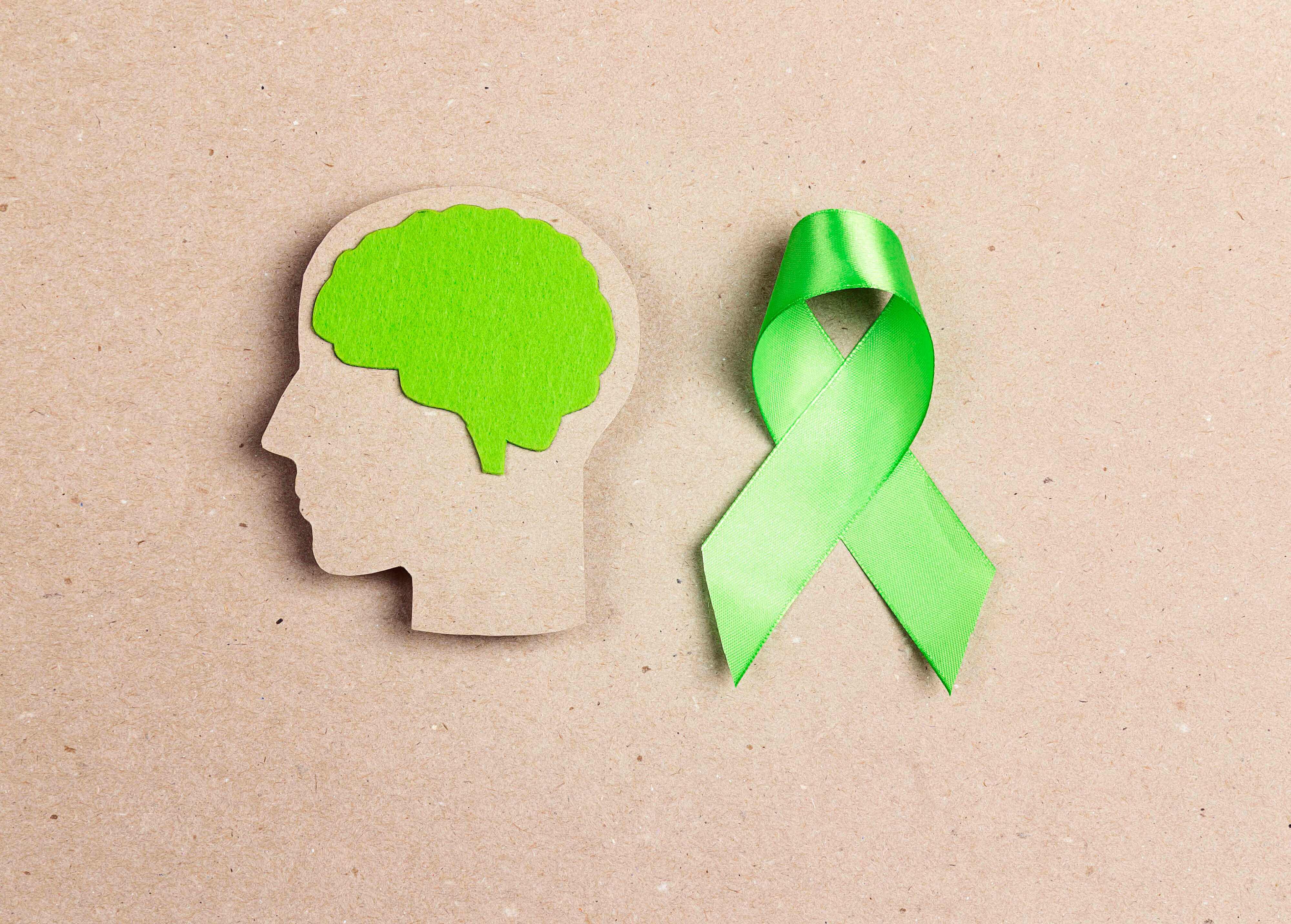Slipped Disk: Causes, Treatment, And Recovery

A slipped disk can happen anywhere along the spine. Despite the name, the intervertebral disk does not slip out of place. Instead, the inner material protrudes through the disk’s outer ring, causing pain that can last weeks or months.
Slipped disks, also called herniated or bulging disks, are a common source of lower back pain. They can also cause pain that radiates into the buttocks and legs, called sciatica.
This article discusses the causes of a slipped disk, common symptoms, treatment options, recovery, and more.
The spine consists of 24 bones, or vertebrae, stacked on top of one another. Between the vertebrae are spinal disks, which have a soft, gel-like center and a tough, flexible outer ring. Spinal disks are flat, round, and about half an inch thick.
A slipped disk occurs when the inner gel-like core of a spinal disk pushes through a tear or weak point in the tough outer layer. This pressure can cause pain.
If the pressure continues, the disk may begin to bulge, or the inner material may push through the outer ring. This may put pressure on the spinal cord and nerve roots nearby.
To compound the problem, the inner disk material releases chemicals that irritate tissues and worsen nerve inflammation.
Nerve root irritation leads to pain, numbness, and weakness in one or both legs or sciatica.
Slipped disks are most common in the lower back or lumbar spine, which has five vertebrae.
The second most common region is in the neck or cervical spine, which has seven vertebrae. The cervical spine supports the skull and allows the head and neck to move.
The area between the cervical spine and lumbar spine is the thoracic spine, and this is the least likely place for a slipped disk to occur.
Read more about a bulging disk in the neck.
The most common cause of a slipped disk is wear and tear, usually through aging. As people age, the intervertebral disks become dehydrated, weaken, and shrink. This leads to a gradual disk herniation that causes symptoms.
Disks can also herniate due to injuries, such as falls, that cause trauma to the spine. Less common causes of herniated disks include connective tissue disorders and congenital abnormalities.
Certain risk factors can increase the chances of experiencing a slipped disk. They include:
- Being male: Males ages 20 to 50 years are most likely to have a slipped disk.
- Unsafe lifting: Lifting heavy objects using the back muscles instead of the leg muscles or twisting while lifting can increase the risk of a slipped disk. Jobs requiring repetitive, strenuous lifting may make back problems more likely.
- Carrying excess weight: Having overweight or obesity adds pressure to the disks in the lower back.
- Being sedentary: Long periods of sitting in one position, such as when driving or sitting at a desk, can put pressure on the spine.
- Smoking: Smoking may decrease oxygen supply to the disks and make them degenerate quicker.
Read about preventing back pain.
Low back pain is often the first symptom of a slipped disk. The pain may be sharp or burning but may decrease after a few days.
Other symptoms may include:
- sciatica
- numbness or tingling in the leg or foot
- weakness in the leg or foot
- loss of bladder or bowel control, which indicates nerve compression and is a medical emergency
Yes. Many people have a slipped disk without experiencing symptoms. They may only find out when they have an examination for another reason.
A physical examination is typically how doctors diagnose a slipped disk. A doctor will ask about a person’s symptoms and medical history and then do the following:
- Check muscle strength by assessing how a person walks on their heels and toes.
- Check whether a person can feel a light touch on their leg and foot.
- Test the reflexes at the knee and ankle, which may be absent if there is nerve root compression.
- While the person lies on their back, slowly raise the painful leg, keeping the knee straight. Pain down the leg and below the knee indicates a slipped disk. This is a straight leg raise test.
- While the person lies on their back, slowly raise the leg that is not painful. If this causes the person’s typical pain, it indicates a slipped disk. This is a crossed straight leg raise test.
In some cases, doctors may recommend an imaging scan, such as an X-ray, MRI scan, CT scan, or CT myelogram, to confirm the diagnosis.
When a person first experiences symptoms of a slipped disk, doctors typically recommend nonsteroidal anti-inflammatory drugs (NSAIDs), such as ibuprofen, to relieve pain and reduce inflammation. They may also recommend resting while the pain is severe.
Using heat or ice on the affected area may also help. During the first days of symptoms, a cold pack can reduce swelling, inflammation, and pain. After a few days, heat from a heating pad, gel, or warm bath may help increase blood circulation, relieve muscle spasms, and improve flexibility.
People can gradually increase their activity level, which will help the body heal faster. It is wise to take precautions during daily activities, such as:
- avoiding long periods of standing, and sitting down regularly (but not for too long)
- moving slowly and steadily, avoiding twisting, bending, and lifting
Most slipped disks will improve in a few weeks. Around 3 weeks after experiencing the first symptoms, a person can begin some gentle exercises to strengthen the muscles around the spine and in the legs.
In severe cases, where pain does not respond to OTC medications, doctors may recommend stronger pain medications, such as opioids, for short periods. Steroid injections may also be an option.
Read about safe exercises for a herniated disk.
Surgery for a slipped disk is a last resort, and doctors may recommend it when more conservative treatments have not improved symptoms. People with prolonged muscle weakness, difficulty walking, and a loss of bowel or bladder control may also benefit from surgery.
Learn more about herniated disk surgery.
The pain from a slipped disk typically improves over several days or weeks. Around 90% of slipped disks that cause symptoms improve after 6 weeks of nonsurgical treatment. However, people may still feel some pain up to a year later.
Being physically active can improve blood flow, strengthen the muscles supporting the spine, and improve recovery.
A slipped disk occurs when the inner gel-like core of a spinal disk pushes through a weak spot in the disk’s tough outer ring. This pressure can cause sharp, burning pain that may radiate into the buttocks or down the legs.
Most slipped disks improve over several weeks or months without needing surgery. Pain-relief medications, heat and ice therapy, and careful movement will help with recovery.



